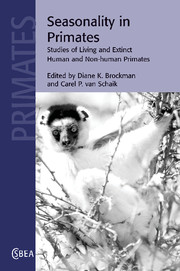Book contents
- Frontmatter
- Contents
- List of contributors
- Preface
- Part I Introduction
- Part II Seasonal habitats
- Part III Seasonality and behavioral ecology
- Part IV Seasonality, reproduction, and social organization
- 10 Seasonality and reproductive function
- 11 Seasonality of primate births in relation to climate
- 12 Energetic responses to food availability in the great apes: implications for hominin evolution
- 13 Human birth seasonality
- 14 Seasonality, social organization, and sexual dimorphism in primates
- Part V Seasonality and community ecology
- Part VI Seasonality and human evolution
- Index
- References
10 - Seasonality and reproductive function
Published online by Cambridge University Press: 10 August 2009
- Frontmatter
- Contents
- List of contributors
- Preface
- Part I Introduction
- Part II Seasonal habitats
- Part III Seasonality and behavioral ecology
- Part IV Seasonality, reproduction, and social organization
- 10 Seasonality and reproductive function
- 11 Seasonality of primate births in relation to climate
- 12 Energetic responses to food availability in the great apes: implications for hominin evolution
- 13 Human birth seasonality
- 14 Seasonality, social organization, and sexual dimorphism in primates
- Part V Seasonality and community ecology
- Part VI Seasonality and human evolution
- Index
- References
Summary
Introduction: types of seasonality
Primates, like other mammals, exhibit varying patterns of reproductive seasonality, spanning the continuum from sharply delineated seasonal periods of mating and births to absolute non-seasonality, where mating and births are distributed broadly throughout the year. Both more qualitative reviews (Lancaster & Lee 1965; Lindberg 1987; Whitten & Brockman 2001) and recent quantitative reviews (Di Bitetti & Janson 2000) (see also Chapter 11) show that seasonal birth distributions are the norm rather than the exception for primates, particularly for species residing at higher latitudes, where food resources undergo pronounced annual seasonal fluctuations (see Chapter 11). Seasonal variation in the frequency of births is also a fairly common phenomenon in human populations (see Chapter 13), although its adaptive significance may have been more pronounced in earlier hominins than in contemporary humans. However, while documentation of the temporal patterning of reproduction and its regulation in primates have advanced steadily over the past few decades, we are a long way from having the detailed interspecific comparisons needed to answer the ultimate question, “Why be seasonal, and if so, how?”
Answers to this question invariably center on how resources are used and are allocated in support of reproductive effort (Drent & Daan 1980; Stearns 1989, 1992) under differing environmental regimes. In seasonal environments, we expect that it is in a female's best interest to align the costliest portion of her reproductive cycle with seasonal food peaks, so that she can acquire the essential resources to compensate for peaks in energy expenditure, thereby enhancing her overall fitness (Sadleir 1969).
- Type
- Chapter
- Information
- Seasonality in PrimatesStudies of Living and Extinct Human and Non-Human Primates, pp. 269 - 306Publisher: Cambridge University PressPrint publication year: 2005
References
- 71
- Cited by



